Also known as fresh coriander, cilantro is a multipurpose aromatic herb grown for its foliage, flowers, seeds, and even roots.
This zesty, fresh herb can brighten up many a meal – and when you grow your own crop of this delicious plant, you can choose from a surprising variety of different types and cultivars!
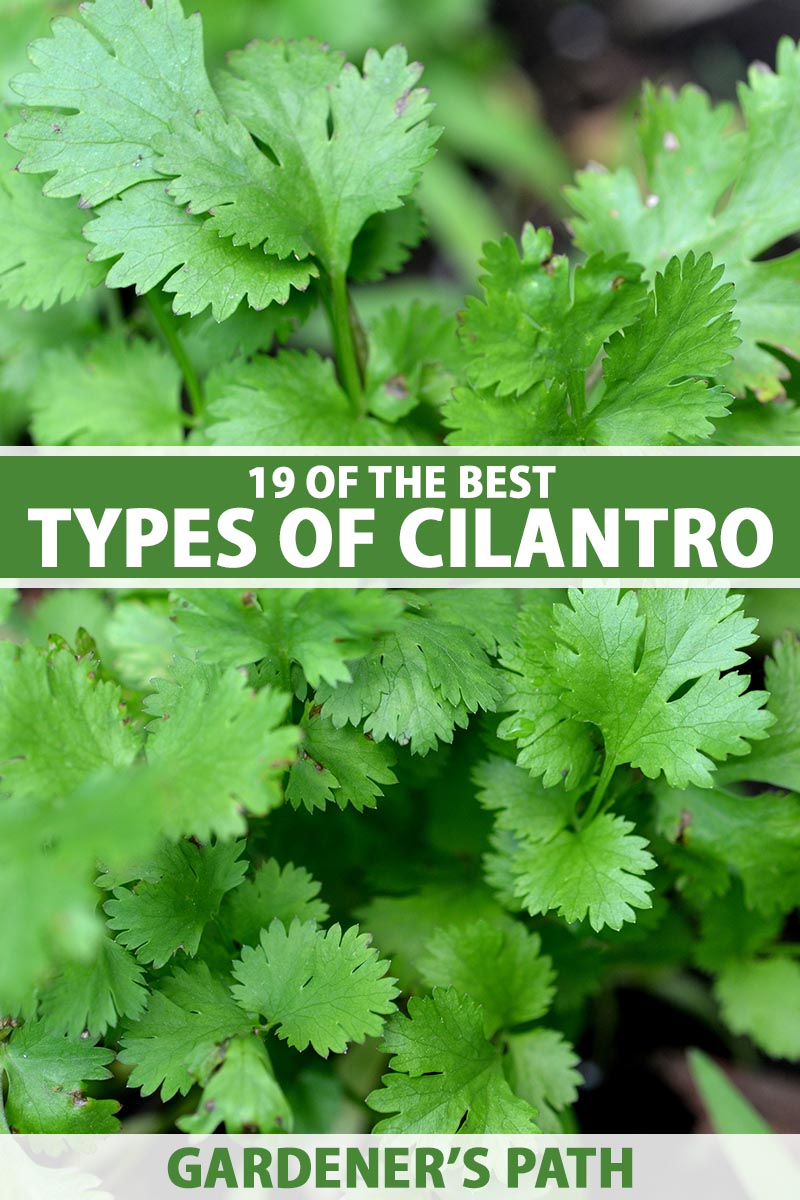
We link to vendors to help you find relevant products. If you buy from one of our links, we may earn a commission.
I have to admit, beyond choosing a slow-bolt cilantro variety, I had never bothered investigating different cultivars until recently.
As a confirmed card-carrying cilantro addict, I just knew I needed to grow plenty of those brightly flavored green leaves every year to transform my meals from not bad to mind blowing.
I’m not sure why I had never looked into different varieties of this herb though.
After all, I have long enjoyed perusing the catalogs and choosing seeds for a multitude of dry and shelling bean cultivars and summer squash varieties year after year.
So when the thought of investigating different types of cilantro dawned on me, I was thrilled with what I found – petite plants, large-leaved giants, heat-resistant champs, and cold weather queens!
In this article we’re going to cover 19 different types of cilantro (or plants with flavors very similar to that of cilantro), to help you select the one of your dreams!
Most of these options are cultivars of the species Coriandrum sativum, but we’ll consider a few outliers as well.
For each option, we’ll touch on a few points of interest, explore culinary uses, and offer some suggestions on where to find seeds or live plants for your own garden.
Ready for a sneak peek? Here’s the roundup:
19 of the Best Cilantro Varieties
Before we get started, if you need any tips on sowing, transplanting, tending to, harvesting, or preserving C. sativum, as well as some enticing suggestions on how to make the most of it in the kitchen, be sure to read our complete guide to growing cilantro.
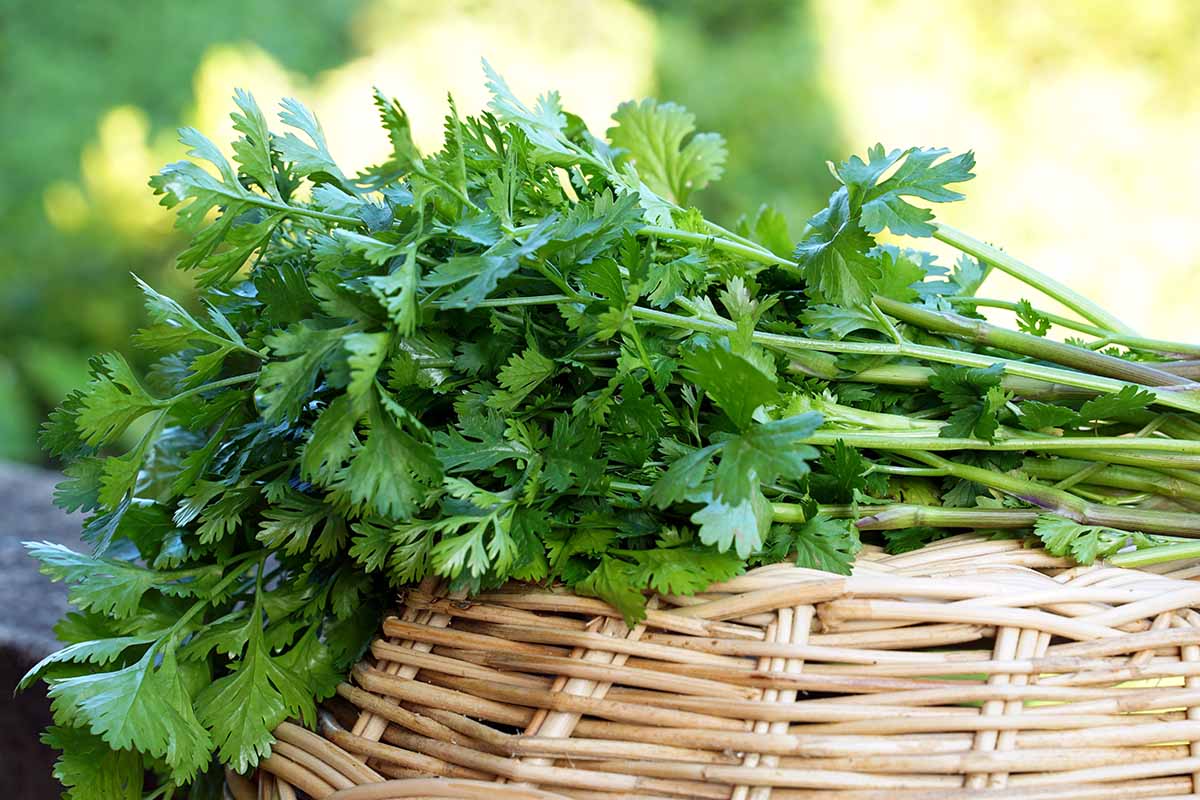
And now, let’s get started with exploring these flavor-packed options!
1. Advanced Turbo II
Our first selection, ‘Advanced Turbo II’ is a disease-resistant and heat-tolerant pick.
‘Advanced Turbo II’ is a fast-growing variety of C. sativum that has gorgeous, glossy green leaves – and it is also slow to bolt.
If you’ve ever experienced issues with bacterial blight on your cilantro crop in the past, try this variety – it is resistant to that bacterial pathogen.
‘Advanced Turbo II’ will be ready to harvest by the bunch in 35 to 40 days.

Why not take advantage of the prolific nature of this fresh coriander variety to make a cilantro-centric sauce that uses lots of fresh foliage?
One of my personal favorites is a delicious Yemeni delight – zhoug sauce. It’s made with fresh coriander leaves, olive oil, lemon juice, cardamom, and a few other spices.
‘Advanced Turbo II’ is currently more common to find for purchase among seed purveyors selling to large-scale farmers rather than those focused on backyard gardeners.
That means this type isn’t the easiest to find, but hopefully it will become more widely available to small-scale gardeners in the future.
2. Calypso
‘Calypso’ is a cultivar of C. sativum known for its bushy plants that are slow to bolt.
This high-yielding variety produces bunches of fresh coriander foliage in 50 to 55 days, or 85 to 105 days for seeds.

Why not take a cue from its West-Indies-flavored name and add the fresh leaves of ‘Calypso’ to a Caribbean-style dish of beans and rice – perhaps with a side of fried plantains?
‘Calypso’ cilantro is available in packs of 100 seeds from the Park Seed Store via Amazon.
3. Caribe
‘Caribe’ is a variety of C. sativum that produces dark green leaves on vigorous plants. Great for greenhouse growing, it’s slow to bolt.
This fresh coriander variety has thinner stems than ‘Santo’ – which we’ll discover later in this article – and even better bolt resistance.
‘Caribe’ produces a harvest of fresh foliage in 55 days, and seeds in around 100 days.
Ever tried adding fresh coriander leaves to chutney? Why not start now?
Get ‘Caribe’ cilantro in an assortment of package sizes ranging from one-eighth of an ounce up to 20 pounds from High Mowing Organic Seeds.
4. Confetti
This next fresh coriander selection may not come with party streamers and noisemakers, but it may give you as much of a surprise as an unexpected celebration!
A cultivar of C. sativum, ‘Confetti’ has finely divided foliage that looks as wispy as carrot or dill greens.
These frilly, medium-green leaves require less chopping and add a different texture to culinary creations.
‘Confetti’ plants are compact and less prone to blemished foliage than other varieties as well.
While not as high yielding as some other C. sativum varieties, ‘Confetti’ has a milder, sweeter flavor.
It’s best harvested for fresh leaves when plants are young, at 30 to 35 days after sowing, and produces seed in 80 to 100 days.
‘Confetti’ requires little prep if you need minced herbs for a recipe, and its fine foliage will be perfect inside rice paper rolls or tacos, or mixed into Asian-style salads.
You can purchase ‘Confetti’ cilantro in packs of 150 seeds from Burpee.
5. Cruiser
A variety of C. sativum, ‘Cruiser’ produces upright plants that bear dark green foliage. Compact, they’re perfect for growing in containers.
Plus, this bolt-resistant fresh coriander variety has excellent flavor, even after going to flower.
‘Cruiser’ will produce a harvest of fresh leaves in 50 to 55 days, and seeds in 120 to 150 days.
Cruising is always best when you keep cool, so why not top a fresh and cooling cucumber salad with the leaves of this tasty variety?
You’ll find ‘Cruiser’ cilantro in a variety of packet sizes from one-eighth of an ounce up to 20 pounds at High Mowing Organic Seeds.
6. Culantro
Our next selection is Eryngium foetidum, a plant that goes by the common name “culantro” – and no, that isn’t a typo!
Culantro is in the same family as C. sativum, the Apiaceae or umbellifer family, and it’s also known by many other common names – including “broadleaf cilantro,” “long leaf coriander,” “Mexican coriander,” “recao,” “ngo gai,” “Vietnamese culantro,” “chado beni,” and “spirit weed.”
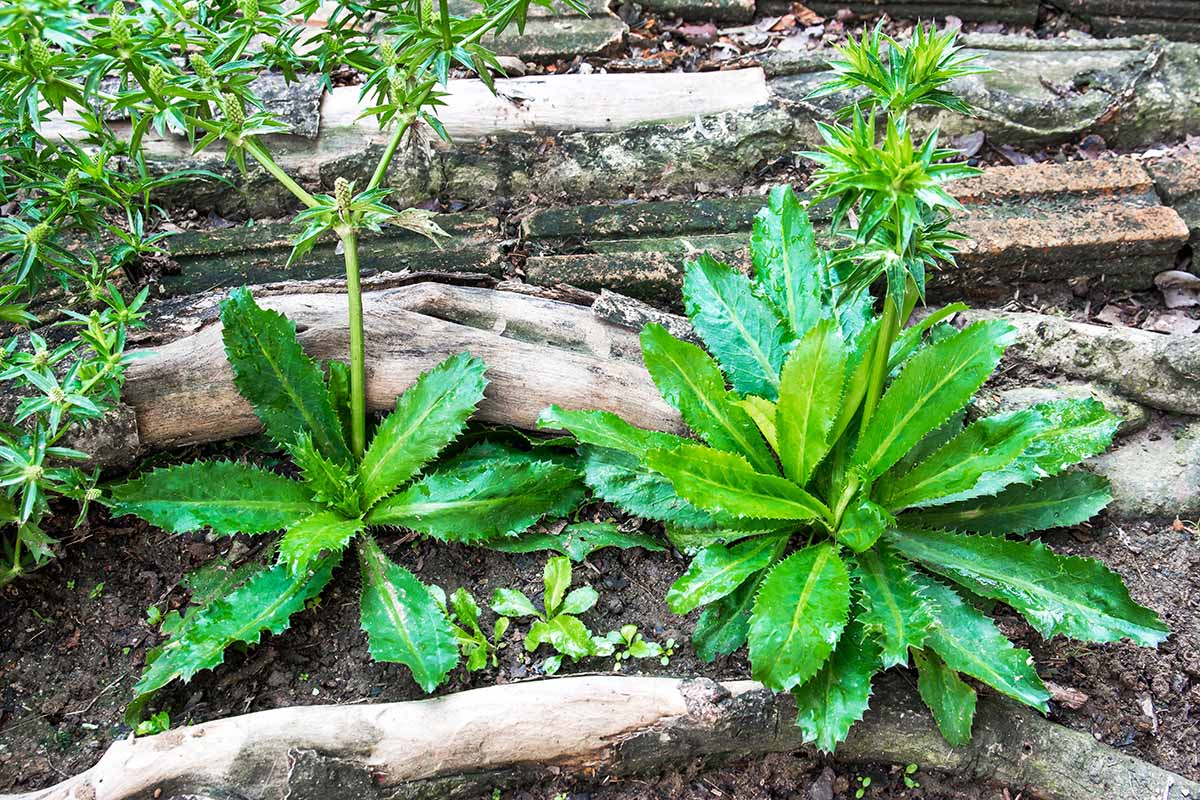
Unlike the frilly, parsley-like leaves of fresh coriander, this plant has long, lance-shaped leaves with serrated edges.
While its flavor is similar to that of cilantro, culantro is even more potent, and when dried it retains its flavor and color better than C. sativum.
Culantro does best when grown in part shade, with moist soil that has a pH of 6.1 to 7.8.
This species reaches 18 to 24 inches tall. It may be grown as a perennial in USDA Hardiness Zones 7 to 11, and produces a harvest of fresh leaves in 80 to 90 days.
These pungent, tasty leaves are a marvel when included in the popular base of so many incredible dishes: the sofrito.
You can purchase culantro in packs of 300 seeds from the Seed Needs Store via Amazon. Packets of 400 and 1200 seeds are available via Walmart.
7. Delfino
After our brief detour to consider a different species, we’re now returning to cultivars of C. sativum with ‘Delfino.’
‘Delfino’ was awarded the distinction of being an All-America Selections winner in 2006.
Like ‘Confetti,’ this variety has finely divided, feathery foliage. But ‘Delfino’ is even more productive in comparison.
‘Delfino’ produces bunches of foliage ready to harvest in 35 days, and sets seed in 80 to 85 days.
With its wispy leaves, this cultivar requires little chopping to add it to a lime cilantro yogurt sauce, an excellent dip for enjoying that bounty of fresh garden veggies you’ll no doubt be growing as well.
Get ‘Delfino’ cilantro in packs of 100 seeds from Hirt’s via Amazon.
8. Dwarf Lemon
C. sativum, ‘Dwarf Lemon’ is a unique, compact choice whose flavor packs a punch.
This fresh coriander cultivar has an intensely pronounced citrusy flavor compared to other varieties of C. sativum and plants are rather petite, reaching just 12 inches tall.
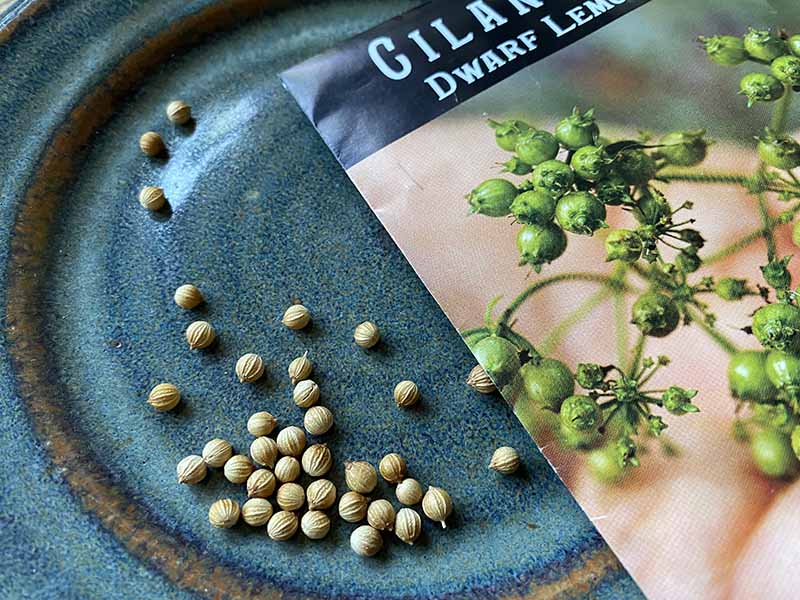
‘Dwarf Lemon’ is delicious when used to garnish any meal where the bright tones of cilantro and citrus are welcome, such as in a rice salad or mixed into hummus.
Count on 50 days of growing time for a harvest of fresh foliage, and 110 days for seeds.
Look for ‘Dwarf Lemon’ cilantro seeds from local suppliers of heirloom seed cultivars.
9. Kanchanaburi
A Thai variety from the town of the same name, ‘Kanchanaburi’ is a prized cultivar of C. sativum for seed production.
This cultivar flowers early and produces large seeds, making it excellent for growing your own coriander spice.
Also known as ‘Kanchanaburu,’ this variety produces short plants with aromatic roots that are also a great choice for cooking.
The foliage of this type can be used for garnishes while it lasts, but the real gem here are its flavorful seeds, which can be used to season so many different dishes, like homemade curries or pickles. Seeds are ready to harvest in about 100 to 120 days.
As an early flowering type, ‘Kanchanaburu’ is also an excellent choice to grow as an insectary plant for pollinators and other beneficial insects.
You’ll find this cilantro variety from sellers of rare, open-pollinated seeds.
10. Large Leaf
‘Large Leaf’ is a variety of C. sativum bred to maximize foliage production, producing up to three times as much as other cultivars.
Very slow to bolt, ‘Large Leaf’ will produce bunches of leaves for harvest in 40 to 50 days, and flowers appear in 90 to 100 days.
Looking for cooking ideas? Mix the oversized leaves of this prolific cultivar with homegrown parsley, oregano, jalapenos, and shallots to make your own chimichurri sauce!
You can find ‘Large Leaf’ cilantro from sellers of rare and heirloom seeds.
11. Leisure
‘Leisure’ is a productive and slow-to-bolt variety of C. sativum.
This coriander cultivar is prized for its uniformity and dependability. Its leaves are medium green in color, feathery, and flat, and they have a delicious, pungent flavor.
‘Leisure’ is heat tolerant, maturing in 50 to 55 days for leaves, and 90 to 105 days for seed.
Does this sound like the perfect garnish to have on hand for leisurely home-cooked meals like coconut Thai soup?
You can purchase ‘Leisure’ cilantro in an assortment of package sizes from High Mowing Organic Seeds.
12. Moroccan
While many varieties of C. sativum are touted for their ability to resist bolting in hot weather, ‘Moroccan’ is another coriander cultivar that goes to flower early.
This makes it desirable for those who are growing this herb to attract pollinators or for seed production.
‘Moroccan’ will produce a harvest of fresh leaves in 45 days, and seeds in as little as 90 days.
Why not grow your own coriander seeds, dry and grind them, and add the powdered coriander to a homemade Moroccan couscous?
You’ll find ‘Moroccan’ for purchase in packs weighing four grams (or approximately 270 seeds) from Botanical Interests.
13. Papalo
Having made it this far, you’re clearly a fan of the distinctive flavor of cilantro, so there’s another herb you might like to know about too – papalo.
Papalo (Porophyllum ruderale) has a flavor described as “a blend of cilantro, arugula, cucumber, and citrus,” by P. Ravindrin, in “The Encyclopedia of Herbs and Spices,” available on Amazon.
Also known as “Bolivian coriander,” “killi,” “papaloquelite,” “poreleaf,” “quilquina,” or ”yerba porosa,” this annual species grows to reach three to five feet tall and has a 12-inch spread.
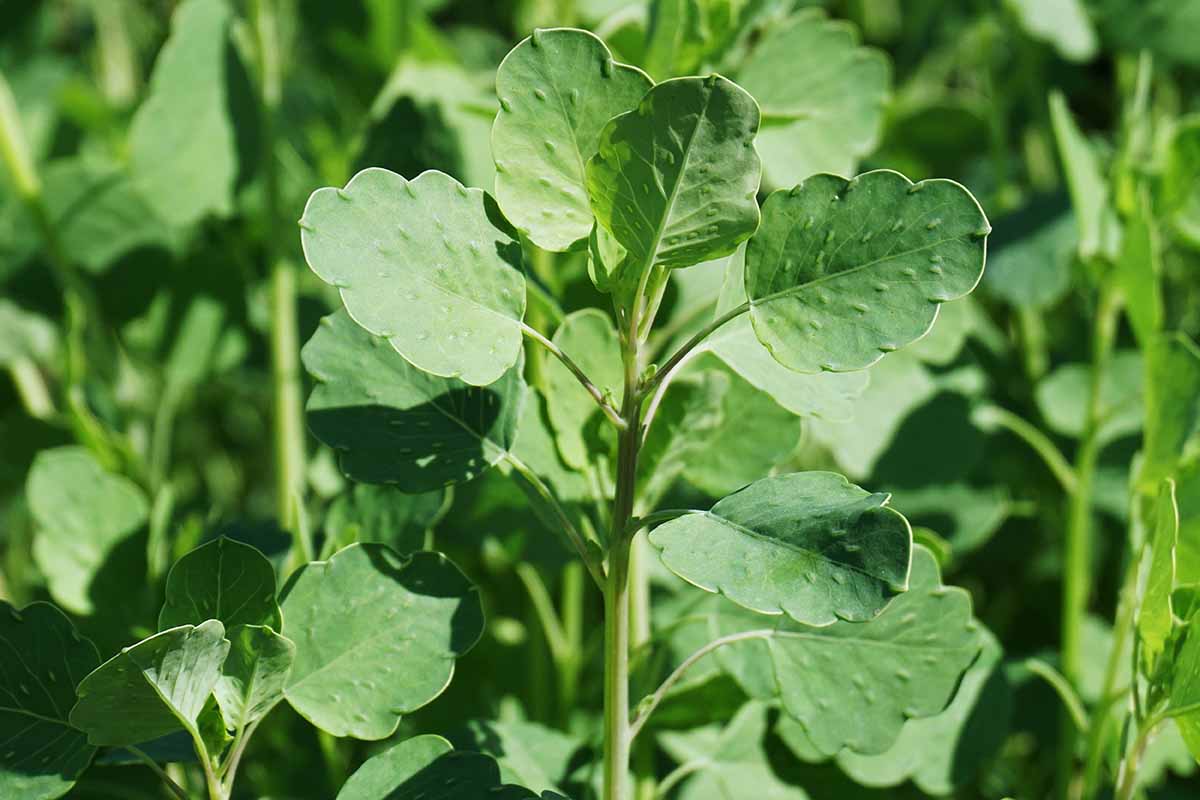
And unlike cilantro, this herb doesn’t bolt in hot weather.
Papalo’s leaves are oval-shaped with scalloped edges. They have a succulent feel, and are marked with glands filled with essential oils.
This plant’s seed head bears a resemblance to that of dandelions – which isn’t too surprising, since both are members of the daisy or Asteraceae family.
Papalo should be grown in full sun or part shade and it only needs moderate water once established.
This herb tastes best fresh, so don’t cook it or dry it – instead, incorporate it into cool or room temperature dishes, or add it to hot meals as a garnish right before serving.

Cilantro tends to bolt by the time tomatoes and hot peppers are ready to pick, but papalo will make a great summer salsa ingredient!
Germination for the seeds of these plants is naturally low, so be sure to sow enough seeds to make up for those that don’t sprout.
You’ll find papalo available for purchase in packets of 20 seeds from the Palm Beach Medicinal Herbs Store, via Amazon.
14. Pokey Joe
If you haven’t given up regular cilantro in favor of papalo after reading about our last selection, here’s one to give it a run for its money – ‘Pokey Joe.’
Also known as ‘Pokey Jo,’ this coriander is slow to bolt and is known for its exquisite flavor, far surpassing the taste of other varieties of cilantro in the opinion of some gardeners.
This rare variety of C. sativum produces a crop of fresh leaves in 50 days, with seeds maturing in around 100 days.
With its fine flavor, this cultivar will really shine when it’s the center of attention – such as in a cilantro pesto, which can be tossed with pasta or spread on a pizza in place of tomato sauce.
Sound appetizing? Get ‘Pokey Joe’ cilantro in packs of 100 seeds via Amazon.
15. Rak Tamachat
A variety of C. sativum with impressive dimensions, this heirloom cultivar was collected in Thailand at the Rak Tamachat Permaculture and Natural Building Education Center by members of the Adaptive Seeds company.
The flavor of ‘Rak Tamachat’ is somewhat milder than other cilantro cultivars, but the real feature of interest is that these large plants grow huge leaves, which are up to two inches wide.
Count on 50 to 60 days for fresh coriander leaves to mature, and 90 to 110 days for seeds.
With its large leaves, this variety will work well for preparing the foliage as a chiffonade, perhaps paired with basil leaves in fresh rice paper rolls.
You’ll find this type available from sellers of rare, open-pollinated seeds.
16. Santo
‘Santo’ is a fast-growing coriander variety that holds up well to heat, and it has an upright growth habit.
Also known as ‘Long Standing,’ ‘Slow Bolt,’ or ‘Slo Bolt,’ this variety of C. sativum produces dark green leaves that have great flavor, making this a favorite cultivar of many gardeners.
As its alternate names suggest, ‘Santo’ is slow to bolt. It’s ready to harvest in 50 to 55 days for bunches of foliage, and 90 to 105 days for seeds.
As an all-around favorite variety among cilantro fans, this cultivar is perfect for use in Mexican or Tex-Mex style dishes such as chili, burritos, or guacamole.
Ready for this long-standing classic? You can purchase certified organic ‘Santo’ cilantro seeds in a variety of package sizes from True Leaf Market.
17. Standby
‘Standby’ is a variety of C. sativum that is slow to bolt and hardy in cold weather, making it a great choice for fall sowing.
Fast to mature, count on 45 days for fresh foliage, and around 100 days for seeds.
Since it’s easy to keep around when the weather is chilly, ‘Standby’ is the perfect cilantro to have on hand to top a warming butternut squash soup in autumn.
Look for ‘Standby’ cilantro from sellers of rare, open-pollinated seeds.
18. Sunmaster
‘Sunmaster’ is a heat-tolerant variety of C. sativum that is very slow to bolt.
This fast-growing and high-yielding coriander cultivar is also very cold hardy and produces large, dark green leaves.
‘Sunmaster’ will mature in approximately 50 to 55 days for leaves, and 100 days for seeds.
The leaves of this variety would be delicious served with either green or brown fava beans and a drizzle of olive oil and lemon juice.
You’ll find ‘Sunmaster’ cilantro on offer from small seed companies.
19. Vietnamese Coriander
Our last selection is another alternative to C. sativum – Vietnamese coriander.
This species, Persicaria odorata, looks rather like mint, but Vietnamese coriander is actually in the Polygonaceae or buckwheat family, related to plants like sorrel and rhubarb.
It tastes much like cilantro, but has a sharper, and more peppery flavor. And unlike C. sativum, Vietnamese coriander doesn’t bolt in hot weather.
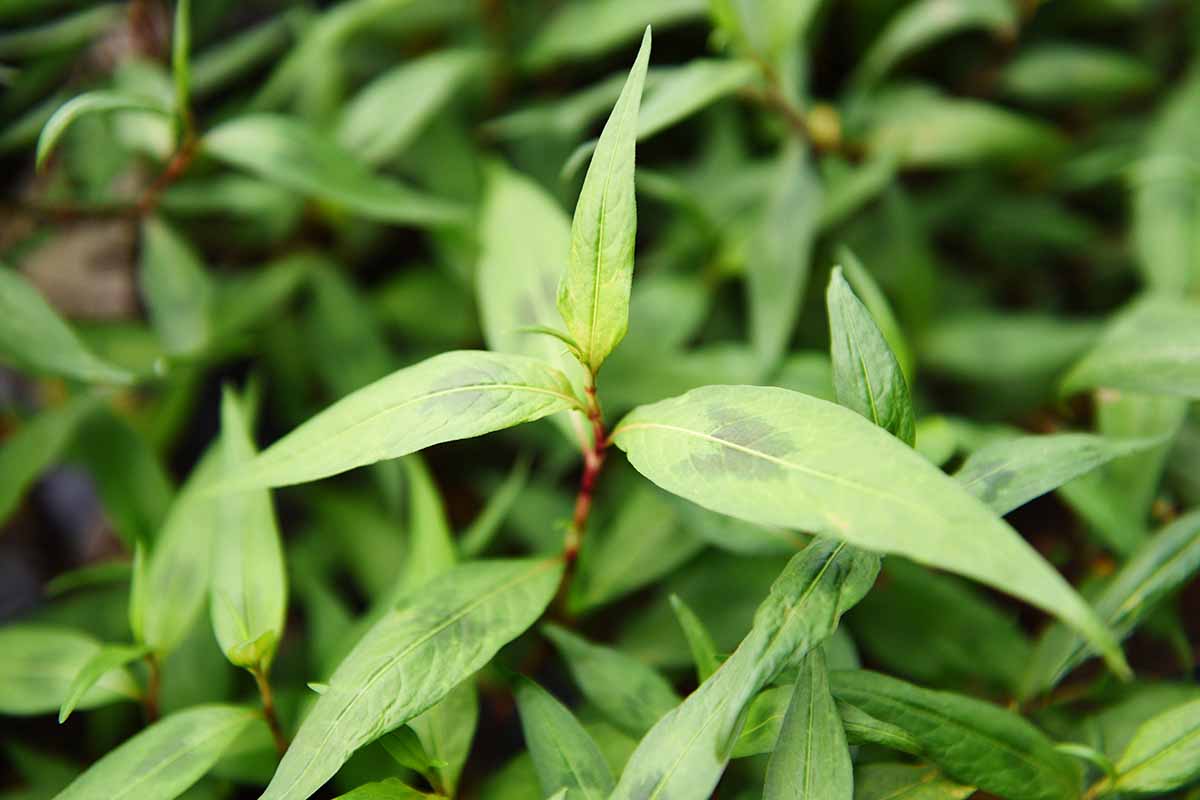
Also known as “rau ram” and “Vietnamese mint,” the leaves of Vietnamese coriander are green and lance shaped, with blotches of burgundy.
Vietnamese coriander is grown in filtered shade and moist soil, but it needs excellent drainage.
This species grows six to 12 inches tall with a spread of six to 18 inches, and is perennial in USDA Hardiness Zones 9b to 12b.
When it comes to flavor, fresh Vietnamese coriander is delicious when used to top a dish of spicy noodles or a bowl of Asian-style soup.
It’s more common to find this species sold as a live plant than it is to see seeds.

Vietnamese Coriander Live Plant in 3” Pot
You’ll find live Vietnamese coriander plants available for purchase in three-inch pots from Hirt’s Garden Store via Amazon.
Your Entry to the Cilantro Collector Club
I bet, like me, you never knew you’d need – or want! – more than one type of cilantro in your life.
But now that you’ve discovered the options, perhaps there are at least a few that will find a regular spot in your garden.
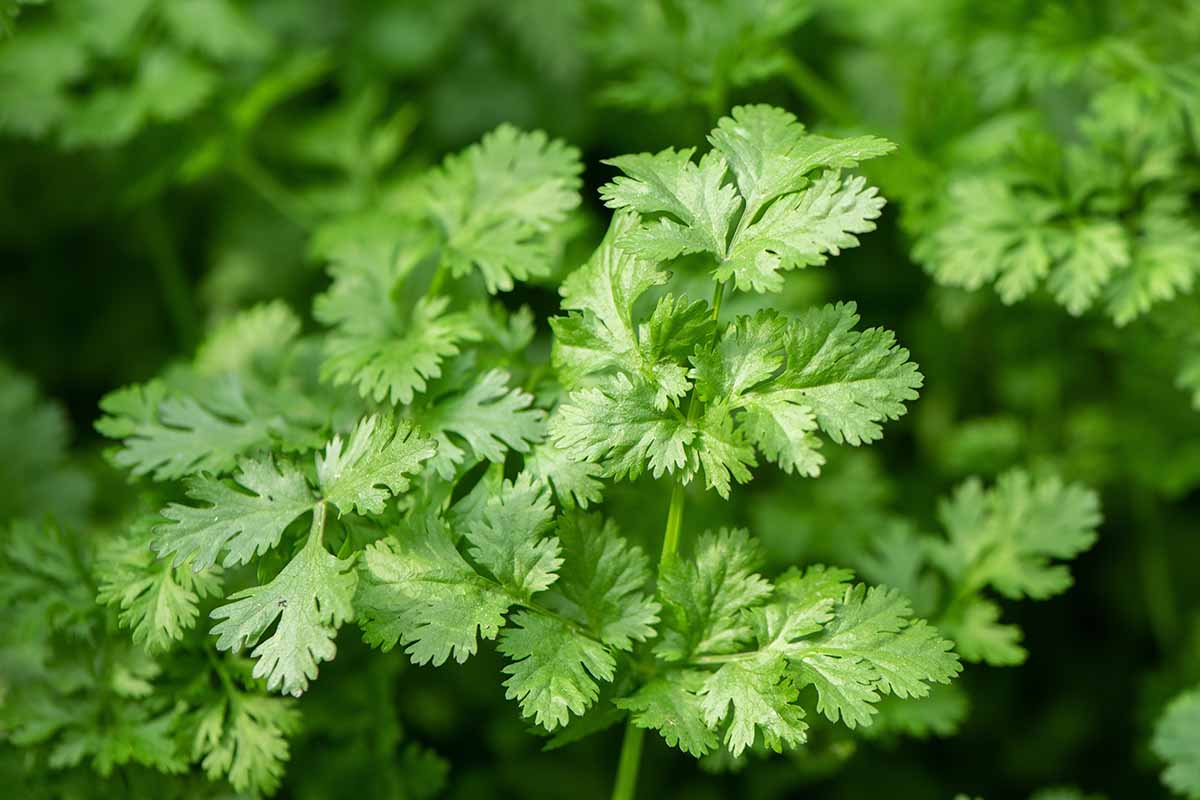
Do you have a personal favorite among these top picks, or one that you’re excited to try? Have I neglected one of your preferred varieties that you think our readers should know about? Tell us in the comments section below!
And while your thoughts are on growing aromatic herbs, why not keep reading about them right here:
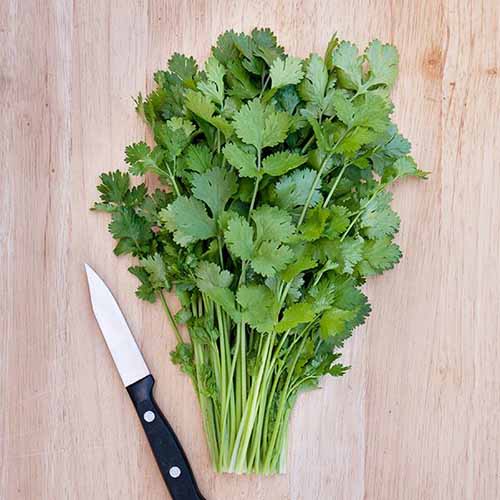
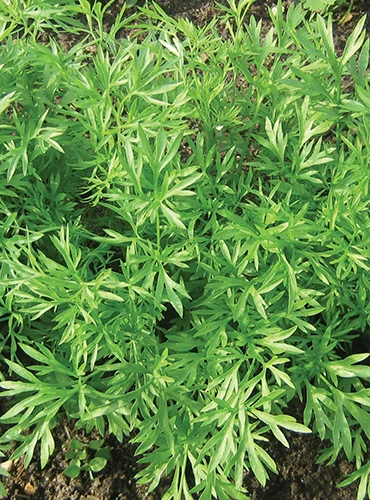

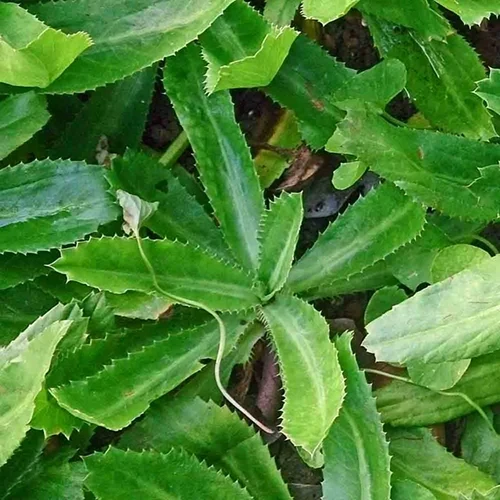

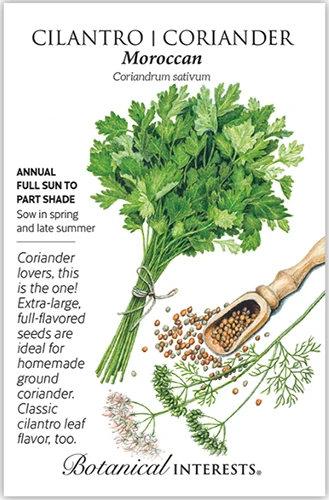
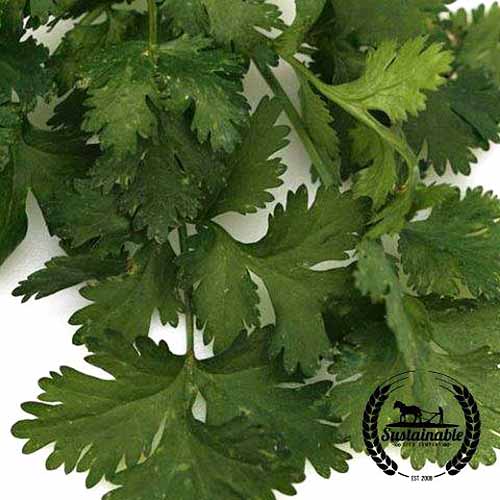
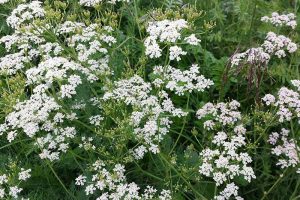
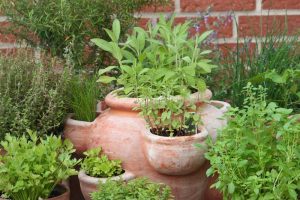

Wondered if you found a variety grown primarily for the roots.
Hi there,
I haven’t tried using the roots myself, but other gardeners like ‘Kanchanaburi’ for their roots. Hope this helps!
The other day while shopping for cilantro I came upon a different looking cilantro U have never seen before,the sign said”cilantro macho” the leaves were the usual flat cilantro I have always been familiar with but it also had some surronding wispy little leaves like dill, I never heard of “Cilantro Macho” how do I find out the correct name of this variety? This cilantro was so fragrant and had a stronger cilantro taste than the more common variety, I fell in love with its stronger flavor.
Hi Jeannie, I hadn’t heard of cilantro macho before, and I’m not finding any seeds available for purchase at this time – apparently it’s a type that has larger seeds. However, I can tell you something about the wispy leaves – they form on cilantro plants when the plant is about to flower. These leaves are much more pungent than the other leaves. You can read more about these leaves in our article on growing cilantro. So I think you may be able to get what you’re looking for by growing another variety and harvesting those wispier leaves that form… Read more »